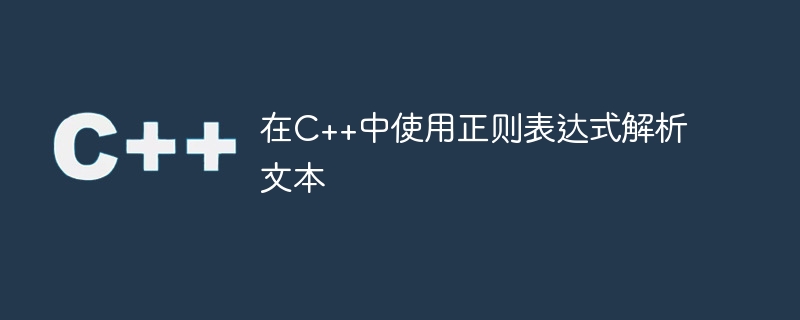在C++中使用正規表示式解析文本
- PHPz原創
- 2023-08-22 14:58:431147瀏覽

在C 中使用正規表示式解析文字
正規表示式是一種強大且靈活的工具,用於匹配和搜尋文字模式。在C 中,我們可以使用正規表示式函式庫來解析文字。
C 中的正規表示式函式庫有兩個主要選擇:std::regex和Boost.Regex。這兩個庫都提供了類似的介面和功能。但是,由於它們的實現方式不同,因此在某些情況下可能存在效能差異。 Boost.Regex通常被認為是更快和更準確的選擇,但它也需要使用Boost庫。
在本文中,我們將介紹如何在C 中使用std::regex函式庫解析文字。我們將透過幾個範例示範如何使用不同的正規表示式語法來匹配和提取文字。
範例1:符合基本文字
在這個範例中,我們將符合一個包含「hello」的字串。
#include <iostream>
#include <regex>
int main() {
std::string text = "hello world!";
std::regex pattern("hello");
if (std::regex_search(text, pattern)) {
std::cout << "Match found!" << std::endl;
} else {
std::cout << "Match not found." << std::endl;
}
return 0;
}這個簡單的程式使用std::regex_search()函數搜尋「hello」字串是否存在於text中。如果找到匹配項,程式將輸出“Match found!”,否則將輸出“Match not found.”。請注意,我們使用了std::string和std::regex類,並將正規表示式作為字串傳遞給regex物件。
範例2:使用元字元
正規表示式中的元字元是指具有特殊意義的字元。以下是一些最常用的元字元及其意義:
- . 匹配任何字元。
- ^ 符合字串的開頭。
- $ 符合字串的結尾。
- d 符合一個數字。
- w 符合一個單字字元(字母、數字或底線)。
- s 符合一個空白字元(空格、製表符等)。
在下面的範例中,我們將匹配任何以「hello」開頭的字串。
#include <iostream>
#include <regex>
int main() {
std::string text1 = "hello world!";
std::string text2 = "world hello!";
std::regex pattern("^hello");
if (std::regex_search(text1, pattern)) {
std::cout << "Match found in text1!" << std::endl;
}
if (std::regex_search(text2, pattern)) {
std::cout << "Match found in text2!" << std::endl;
}
return 0;
}這個例子中,我們使用元字元「^」來匹配以「hello」開頭的字串。在第一個文字「hello world!」中,正規表示式和字串都以「hello」開頭,因此程式將輸出「Match found in text1!」。在第二個文字「world hello!」中,正規表示式不與字串開頭匹配,因此程式將輸出什麼也不輸出。
範例3:使用量詞
正規表示式中的量詞指定模式匹配的次數。以下是一些最常用的量詞及其意義:
- 符合前面的模式零次或多次。
- 符合前面的模式一次或多次。
- ? 符合前面的模式零次或一次。
- {n} 符合前面的模式剛好n次。
- {n,} 符合前面的模式至少n次。
- {n,m} 符合前面的模式至少n次,但不超過m次。
在下面的範例中,我們將使用量詞「 」來匹配一個或多個數字。
#include <iostream>
#include <regex>
int main() {
std::string text1 = "1234";
std::string text2 = "a1234";
std::regex pattern("\d+");
if (std::regex_search(text1, pattern)) {
std::cout << "Match found in text1!" << std::endl;
}
if (std::regex_search(text2, pattern)) {
std::cout << "Match found in text2!" << std::endl;
}
return 0;
}在這個例子中,我們使用正規表示式「d 」來匹配一個或多個數字。在第一個文字「1234」中,正規表示式與整個字串匹配,因此程式將輸出「Match found in text1!」。在第二個文字「a1234」中,正規表示式只與數字子字串「1234」匹配,因此程式將輸出「Match found in text2!」。
範例4:使用分組
正規表示式中的分組允許我們將模式拆分為子模式,並在匹配時只考慮其中一個。分組使用括號表示。在下面的範例中,我們將匹配包含“hello”或“world”的字串。
#include <iostream>
#include <regex>
int main() {
std::string text1 = "hello";
std::string text2 = "world";
std::string text3 = "hello world!";
std::regex pattern("(hello|world)");
if (std::regex_search(text1, pattern)) {
std::cout << "Match found in text1!" << std::endl;
}
if (std::regex_search(text2, pattern)) {
std::cout << "Match found in text2!" << std::endl;
}
if (std::regex_search(text3, pattern)) {
std::cout << "Match found in text3!" << std::endl;
}
return 0;
}在這個例子中,我們使用正規表示式「(hello|world)」將「hello」和「world」作為兩個分組。在第一個文字「hello」中,正規表示式只與第一個分組匹配,因此程式將輸出「Match found in text1!」。在第二個文字「world」中,正規表示式只與第二個分組匹配,因此程式將輸出「Match found in text2!」。在第三個文字「hello world!」中,正規表示式與第一個或第二個分組匹配,因此程式將輸出「Match found in text3!」。
總結
在這篇文章中,我們介紹如何在C 中使用正規表示式解析文字。我們詳細介紹了一些最常用的正規表示式語法,包括元字元、量詞和分組。希望這些範例能夠幫助您更好地理解如何利用正規表示式來處理文字資料。
以上是在C++中使用正規表示式解析文本的詳細內容。更多資訊請關注PHP中文網其他相關文章!

